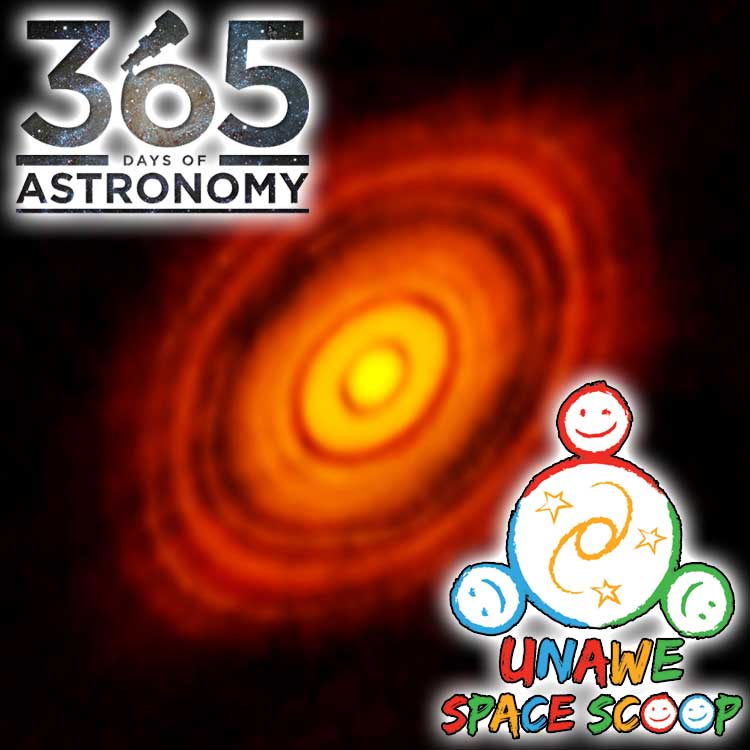Podcaster: Richard Drumm
Title: Space Scoop: Planets Grow Up So Fast
Organization: Astrosphere New Media
Link : astrosphere.org ; http://unawe.org/kids/unawe1447/
Description: Space scoop, news for children.
Bio: Richard Drumm is President of the Charlottesville Astronomical Society and President of 3D – Drumm Digital Design, a video production company with clients such as Kodak, Xerox and GlaxoSmithKline Pharmaceuticals. He was an observer with the UVa Parallax Program at McCormick Observatory in 1981 & 1982. He has found that his greatest passion in life is public outreach astronomy and he pursues it at every opportunity.
Today’s sponsor: This episode of “365 Days of Astronomy” is sponsored by — no one. We still need sponsors for many days in 2013, so please consider sponsoring a day or two. Just click on the “Donate” button on the lower left side of this webpage, or contact us at signup@365daysofastronomy.org.
Transcript:
This is 365 Days of Astronomy. Today we bring you a new episode in our Space Scoop series. This show is produced in collaboration with Universe Awareness, a program that strives to inspire every child with our wonderful cosmos.
Today’s story is…
Planets Grow Up So Fast
Astronomers have captured an amazing new space photograph showing the birth of a Solar System!
Earth and the other seven planets of our Solar System are not alone in the Universe. Over 1,800 planets have been discovered around distant stars so far, and this number is rising!
Stars and planets form when a giant cloud of cosmic gas and dust in space collapses in on itself. All of this gas and dust begins to move in a circle as it falls towards the center. This is similar to the way water circles the drain hole in a bathtub before falling through.
The gas and dust at the center get very dense and hot until a star is born. Around the star, the whirling cloud of leftover gas and dust begins to separate out into a thick ring. It’s this part of the story that has been captured in the new photograph that’s in this episode’s album artwork.
Now this is an actual image, not an artist’s conception. This is the real deal, folks! The image was created from data gathered by the ALMA radio telescope array in Chile as it was pointed at the young star HL Tauri in the constellation Taurus.
This protoplanetary disk is 450 light years away from Earth and is no more than 1 million years old. “This one image alone will revolutionize theories of planet formation,” said Dr. Catherine Vlahakis, ALMA Deputy Program Scientist.
Yeah. ALMA’s gotchu covered!
You wanna know what it looks like when planets form in a protoplanetary disk? ALMA gotchu!
Over millions of years the particles in the thicker parts of the disc stick together, growing into larger clumps. As they grow in size, their gravity also grows. They pull more material onto them, growing ever larger until eventually planets are born!
The planets’ gravity clears out a dark, dust-free lane or gap in the disk. Some of the dark rings we see here are where the planets are forming, and some may be where there are resonant orbits for the large planetesimals, that is, where the orbital period of the dust is a simple multiple of the orbital period of the large planetesimal.
This is basically where the zone gets cleared out with no planet present in there. The yellow bit in the very center? Thst’s where the star is still forming.
This image has only been out for a bit over a month, and there’s no scientific paper that’s been published about it yet, so it’s a work in progress. The image is actually sort of a test image, a demonstration, part of the so-called Science Verification phase of the high resolution Long Baseline Campaign.
The 25 to 30 antennas used here were trained on HL Tau (as it’s called) for 4.5 hours in late October. Once the engineers at ALMA have finished with the data on this object the data will be released to the world’s scientists and journal articles will follow.
This is the best photograph ever taken of planets forming around a newborn star, it shows an incredible amount of detail. But it isn’t just the spectacular, pretty picture that has astronomers excited; it’s also what it shows.
Because this star is so young, astronomers didn’t expect to see planets already beginning to form around it. This new picture tells us that planets might grow faster than we thought!
Here’s a Cool Fact: If an alien had taken a photograph of our Solar System 4.6 billion years ago, it would have looked very similar to this one!
Thank you for listening to 365 Days of Astronomy!
End of podcast:
365 Days of Astronomy
=====================
The 365 Days of Astronomy Podcast is produced by Astrosphere New Media. Audio post-production by Richard Drumm. Bandwidth donated by libsyn.com and wizzard media. You may reproduce and distribute this audio for non-commercial purposes. Please consider supporting the podcast with a few dollars (or Euros!). Visit us on the web at 365DaysOfAstronomy.org or email us at info@365DaysOfAstronomy.org. In the new year the 365 Days of Astronomy project will be something different than before….Until then…goodbye


